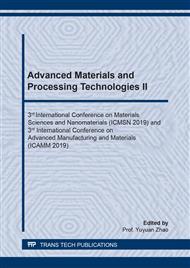[1]
Heigel, J. C., Michaleris, P., & Palmer, T. A. (2015). In situ monitoring and characterization of distortion during laser cladding of Inconel® 625. Journal of Materials Processing Technology, 220, 135-145. https://doi.org/10.1016/j.jmatprotec.2014.12.029.
DOI: 10.1016/j.jmatprotec.2014.12.029
Google Scholar
[2]
Gong, H., Rafi, K., Gu, H., Starr, T., & Stucker, B. (2014). Analysis of defect generation in Ti–6Al–4V parts made using powder bed fusion additive manufacturing processes. Additive Manufacturing, 1, 87-98. https://doi.org/10.1016/j.addma.2014.08.002.
DOI: 10.1016/j.addma.2014.08.002
Google Scholar
[3]
Li, R., Liu, J., Shi, Y., Wang, L., & Jiang, W. (2012). Balling behavior of stainless steel and nickel powder during selective laser melting process. The International Journal of Advanced Manufacturing Technology, 59(9-12), 1025-1035. https://doi.org/10.1007/s00170-011-3566-1.
DOI: 10.1007/s00170-011-3566-1
Google Scholar
[4]
Ning, J., & Liang, S. Y. (2018). Prediction of Temperature Distribution in Orthogonal Machining Based on the Mechanics of the Cutting Process Using a Constitutive Model. Journal of Manufacturing and Materials Processing, 2(2), 37. https://doi.org/10.3390/jmmp2020037.
DOI: 10.3390/jmmp2020037
Google Scholar
[5]
Ning, J., & Liang, S. Y. (2018). Evaluation of an Analytical Model in the Prediction of Machining Temperature of AISI 1045 Steel and AISI 4340 Steel. Journal of Manufacturing and Materials Processing, 2(4), 74. https://doi.org/10.3390/jmmp2040074.
DOI: 10.3390/jmmp2040074
Google Scholar
[6]
Ning, J., & Liang, S. Y. (2019). Predictive modeling of machining temperatures with force-temperature correlation using cutting mechanics and constitutive relation. Materials, 12(2), 284. https://doi.org/10.3390/ma12020284.
DOI: 10.3390/ma12020284
Google Scholar
[7]
Peyre, P., Aubry, P., Fabbro, R., Neveu, R., & Longuet, A. (2008). Analytical and numerical modelling of the direct metal deposition laser process. Journal of Physics D: Applied Physics, 41(2), 025403.
DOI: 10.1088/0022-3727/41/2/025403
Google Scholar
[8]
Everton, S. K., Hirsch, M., Stravroulakis, P., Leach, R. K., & Clare, A. T. (2016). Review of in-situ process monitoring and in-situ metrology for metal additive manufacturing. Materials & Design, 95, 431-445. https://doi.org/10.1016/j.matdes.2016.01.099.
DOI: 10.1016/j.matdes.2016.01.099
Google Scholar
[9]
Fu, C. H., & Guo, Y. B. (2014). Three-dimensional temperature gradient mechanism in selective laser melting of Ti-6Al-4V. Journal of Manufacturing Science and Engineering, 136(6), 061004.
DOI: 10.1115/1.4028539
Google Scholar
[10]
Roberts, I. A., Wang, C. J., Esterlein, R., Stanford, M., & Mynors, D. J. (2009). A three-dimensional finite element analysis of the temperature field during laser melting of metal powders in additive layer manufacturing. International Journal of Machine Tools and Manufacture, 49(12-13), 916-923. https://doi.org/10.1016/j.ijmachtools.2009.07.004.
DOI: 10.1016/j.ijmachtools.2009.07.004
Google Scholar
[11]
Li, C., Liu, J. F., & Guo, Y. B. (2016). Prediction of residual stress and part distortion in selective laser melting. Procedia CIRP, 45, 171-174. https://doi.org/10.1016/j.procir.2016.02.058.
DOI: 10.1016/j.procir.2016.02.058
Google Scholar
[12]
Afazov, S., Denmark, W. A., Toralles, B. L., Holloway, A., & Yaghi, A. (2017). Distortion prediction and compensation in selective laser melting. Additive Manufacturing, 17, 15-22. https://doi.org/10.1016/j.addma.2017.07.005.
DOI: 10.1016/j.addma.2017.07.005
Google Scholar
[13]
Ning, J., & Liang, S. Y. (2019). A comparative study of analytical thermal models to predict the orthogonal cutting temperature of AISI 1045 steel, The International Journal of Advanced Manufacturing Technology, 102(9-12), 3109-3119. https://doi.org/10.1007/s00170-019-03415-9.
DOI: 10.1007/s00170-019-03415-9
Google Scholar
[14]
Ning, J., Nguyen, V., & Liang, S. Y. (2018). Analytical modeling of machining forces of ultra-fine-grained titanium. The International Journal of Advanced Manufacturing Technology, 101(1-4), 627-636. https://doi.org/10.1007/s00170-018-2889-6.
DOI: 10.1007/s00170-018-2889-6
Google Scholar
[15]
Van Elsen, M., Baelmans, M., Mercelis, P., & Kruth, J. P. (2007). Solutions for modelling moving heat sources in a semi-infinite medium and applications to laser material processing. International Journal of heat and mass transfer, 50(23-24), 4872-4882. https://doi.org/10.1016/j.ijheatmasstransfer.2007.02.044.
DOI: 10.1016/j.ijheatmasstransfer.2007.02.044
Google Scholar
[16]
Carslaw, H. S., & Jaeger, J. C. (1959). Conduction of heat in solids: Oxford Science Publications. Oxford, England.
Google Scholar
[17]
Rosenthal, D. (1946). The theory of moving sources of heat and its application of metal treatments. Transactions of ASME, 68, 849-866.
DOI: 10.1115/1.4018626
Google Scholar
[18]
de La Batut, B., Fergani, O., Brotan, V., Bambach, M., & El Mansouri, M. (2017). Analytical and numerical temperature prediction in direct metal deposition of Ti6Al4V. Journal of Manufacturing and Materials Processing, 1(1), 3. https://doi.org/10.3390/jmmp1010003.
DOI: 10.3390/jmmp1010003
Google Scholar
[19]
Mirkoohi, E., Ning, J., Bocchini, P., Fergani, O., Chiang, K. N., & Liang, S. (2018). Thermal modeling of temperature distribution in metal additive manufacturing considering effects of build layers, latent heat, and temperature-sensitivity of material properties. Journal of Manufacturing and Materials Processing, 2(3), 63. https://doi.org/10.3390/jmmp2030063.
DOI: 10.3390/jmmp2030063
Google Scholar
[20]
Ning, J., Sievers, D. E., Garmestani, H., & Liang, S. Y. (2019). Analytical Modeling of In-Process Temperature in Powder Bed Additive Manufacturing Considering Laser Power Absorption, Latent Heat, Scanning Strategy, and Powder Packing. Materials, 12(5), 808. https://doi.org/10.3390/ma12050808.
DOI: 10.3390/ma12050808
Google Scholar
[21]
Yang, Y., Knol, M. F., van Keulen, F., & Ayas, C. (2018). A semi-analytical thermal modelling approach for selective laser melting. Additive Manufacturing, 21, 284-297. https://doi.org/10.1016/j.addma.2018.03.002.
DOI: 10.1016/j.addma.2018.03.002
Google Scholar
[22]
Schoinochoritis, B., Chantzis, D., & Salonitis, K. (2017). Simulation of metallic powder bed additive manufacturing processes with the finite element method: A critical review. Proceedings of the Institution of Mechanical Engineers, Part B: Journal of Engineering Manufacture, 231(1), 96-117. https://doi.org/10.1177/0954405414567522.
DOI: 10.1177/0954405414567522
Google Scholar
[23]
Roberts, I. A., Wang, C. J., Esterlein, R., Stanford, M., & Mynors, D. J. (2009). A three-dimensional finite element analysis of the temperature field during laser melting of metal powders in additive layer manufacturing. International Journal of Machine Tools and Manufacture, 49(12-13), 916-923. https://doi.org/10.1016/j.ijmachtools.2009.07.004.
DOI: 10.1016/j.ijmachtools.2009.07.004
Google Scholar
[24]
Kruth, J. P., Levy, G., Klocke, F., & Childs, T. H. C. (2007). Consolidation phenomena in laser and powder-bed based layered manufacturing. CIRP Annals, 56(2), 730-759. https://doi.org/10.1016/j.cirp.2007.10.004.
DOI: 10.1016/j.cirp.2007.10.004
Google Scholar


